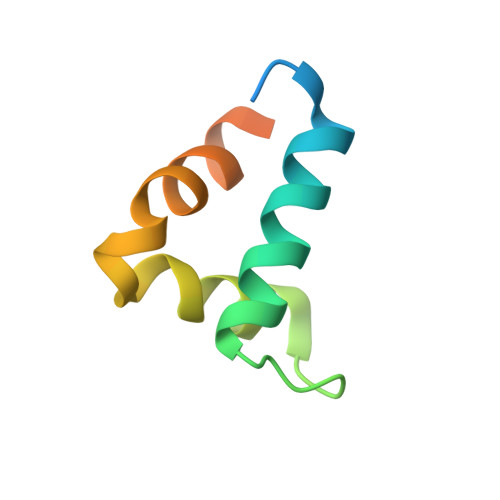Nonnative interactions in the FF domain folding pathway from an atomic resolution structure of a sparsely populated intermediate: an NMR relaxation dispersion study.
Korzhnev, D.M., Vernon, R.M., Religa, T.L., Hansen, A.L., Baker, D., Fersht, A.R., Kay, L.E.(2011) J Am Chem Soc 133: 10974-10982
- PubMed: 21639149
- DOI: https://doi.org/10.1021/ja203686t
- Primary Citation of Related Structures:
2L9V - PubMed Abstract:
Several all-helical single-domain proteins have been shown to fold rapidly (microsecond time scale) to a compact intermediate state and subsequently rearrange more slowly to the native conformation. An understanding of this process has been hindered by difficulties in experimental studies of intermediates in cases where they are both low-populated and only transiently formed. One such example is provided by the on-pathway folding intermediate of the small four-helix bundle FF domain from HYPA/FBP11 that is populated at several percent with a millisecond lifetime at room temperature. Here we have studied the L24A mutant that has been shown previously to form nonnative interactions in the folding transition state. A suite of Carr-Purcell-Meiboom-Gill relaxation dispersion NMR experiments have been used to measure backbone chemical shifts and amide bond vector orientations of the invisible folding intermediate that form the input restraints in calculations of atomic resolution models of its structure. Despite the fact that the intermediate structure has many features that are similar to that of the native state, a set of nonnative contacts is observed that is even more extensive than noted previously for the wild-type (WT) folding intermediate. Such nonnative interactions, which must be broken prior to adoption of the native conformation, explain why the transition from the intermediate state to the native conformer (millisecond time scale) is significantly slower than from the unfolded ensemble to the intermediate and why the L24A mutant folds more slowly than the WT.
Organizational Affiliation:
Department of Molecular Genetics, The University of Toronto, Toronto, Ontario M5S 1A8, Canada.














